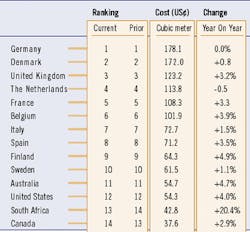A recent survey by the NUS Consulting Group studying water rates around the world found that rates increased in 12 of the 14 countries surveyed. Water rates in the United States were among the lowest in the countries surveyed, and were one half to one third the rates charged in most European countries.
The majority of countries included within the survey reported water prices increasing above their respective rates of inflation. South Africa had the largest percentage increase in pricing with a jump of 20.4 percent in the price of water from last year. Only the Netherlands reported a slight decrease of 0.5 percent compared to 2001, while Germany, the most expensive country surveyed, reported no change in pricing. The US saw a 4 percent increase in prices.
The survey was based on prices as of July 1, 2002, for an organization with an annual usage of 10,000 cubic meters. Where there was more than a single supplier, an unweighted average of available prices was used. The percentage change for each country was calculated using the local currency in order to eliminate currency movement distortion.
As demonstrated in this year's survey, the rise in water prices is mainly due to two factors – the first being the need to ensure the quality of supply and the second being the need to increase conservation measures. As reported in last year's survey, this water industry "sleeping giant" is beginning to awaken and consumers, both residential and business alike, must prepare themselves for higher prices and less secure supply.
Europe has the highest water costs in the world and this trend is likely to continue. Germany and Denmark pay the highest prices for water on the Continent, at $1.78 and $1.72 per cubic meter, respectively. Rates in the United Kingdom, France, Belgium and The Netherlands were all above $1 per cubic meter of water.
Italy, whose water prices are relatively low in comparison to their European neighbors, at 72.7 cents per cubic meter, has forecasted significant increases as it conforms to EU regulations and expands it current infrastructure.
Having enjoyed success in deregulating their electricity and gas industries, some countries are grappling with this issue in the area of water. The United Kingdom is undertaking a pilot program and Germany is active in exploring ways of deregulating its market. However, water is one of the most politically sensitive subjects and quality supply, not price, remains the paramount concern.
In North America, the issues of water quality, scarcity of supply and aging infrastructure continue to take center stage. Once a cheap resource with a seemingly unending supply, water quality and quantity are becoming dominant issues. Aging infrastructures coupled with new Federal regulations are forcing local municipalities to increase prices.
The survey found the average rate for water in the US was 54.3 cents per cubic meter, ahead of only South Africa and Canada in the survey. Canada, once a haven for cheap supply, is facing increases as water quality and methods of ensuring safe supply are beginning to take root.
Of the fifty-one US cities sampled in this year's international water survey, the overall increase in the average price of water rose by 4.0 percent, reflecting an increase nearly double last year's rise of 2.2 percent. More significantly, the 2001 survey had only four municipalities reflecting double-digit increases whereas this year's study showed eight cities had service increases over 10 percent.
Cities having such significant increases included Fort Smith, AR (+37.5%), Boston, (+24.4%), Dover, DE (+23.9%), Binghamton, NY (+20.2%), Roanoke, VA (+17.3%), Duluth, MN (+16.6%), Albany, NY (+14.7%) and Los Angeles, (+12.3%). While most increases reflected costs for new construction and upgrading of maintenance systems, the increases in Roanoke and Los Angeles also reflected measures to increase water conservation.
According to NUS, many water systems throughout the United States do not currently meet new federal clean water guidelines and are faced with massive costs in order to meet such regulations. Along with tougher measures to ensure clean drinking water, many areas of the country are faced with severe drought conditions. Many water systems are finding themselves in unique situations wherein local governments are introducing curbs on water consumption and the water company is attempting to increase revenue. Reduced water sales equate to lower operating profits and thus costs are bound to increase for supply.
Of the surveyed cities, Huntington, WV, reported the highest price for water at $1.27 per cubic meter, while Greenville, MI, recorded the lowest price at 21¢ per cubic meter.
In the coming years, the United States will continue to experience even greater increases in prices as water quality is subject to stricter federal regulations, city systems deal with aging infrastructure and government authorities introduce additional measures to promote water conservation.
The NUS Consulting Group is an independent cost control and consulting organization operating in 16 countries around the world through 11 wholly owned subsidiaries. More information on the organization and it's water rates survey may be obtained by visiting the company's website at www.nusconsulting.com.




